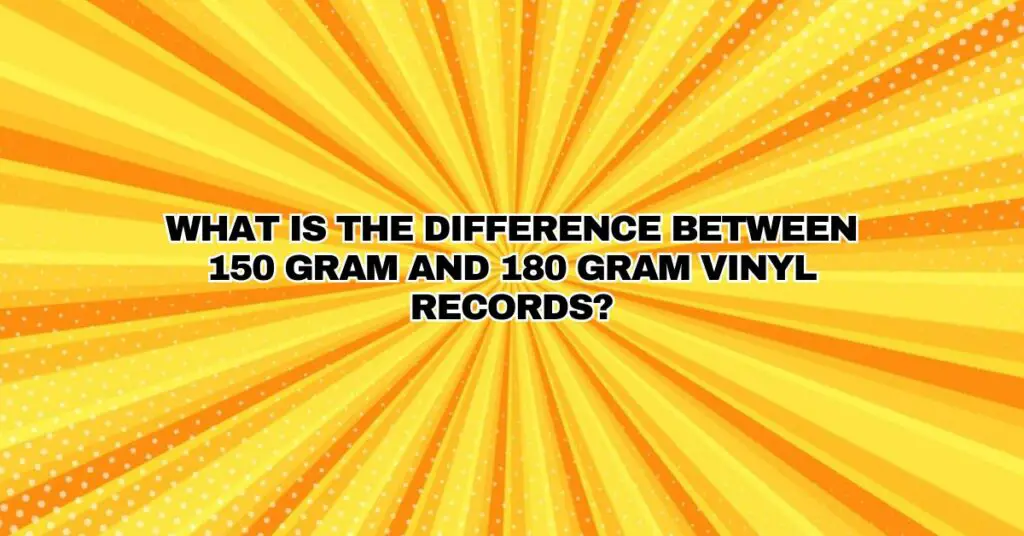As the vinyl record resurgence continues to captivate audiophiles and music enthusiasts, the age-old debate over vinyl weight remains a hot topic of discussion. Among the various vinyl weight options, 150-gram and 180-gram records are two common contenders. But what distinguishes them? Is there a significant difference in sound quality, durability, or collectibility? In this in-depth exploration, we will dissect the disparities between 150-gram and 180-gram vinyl records, helping you make an informed choice for your analog music collection.
Read Also : Is vinyl 140g or 180g or 200g better?
Cracking the Vinyl Code
Before delving into the specifics of vinyl weight, it’s crucial to understand the fundamental components of a vinyl record. Vinyl records are flat, circular discs crafted from polyvinyl chloride (PVC). Music is etched into the record’s surface as grooves. When a turntable’s stylus or needle navigates these grooves, it converts physical vibrations into audible sound, delivering the unique analog listening experience cherished by many.
The Evolution of Vinyl Weights
The history of vinyl records is marked by the transformation of formats and materials. In the early 20th century, shellac records were the norm, characterized by their fragility and weight. However, the introduction of the 33 1/3 RPM long-playing (LP) record and the 45 RPM single brought significant changes to the music industry.
Early vinyl records were relatively thin, typically weighing around 120-140 grams. These records were susceptible to warping and damage due to their lightweight build. As technology advanced, record labels began experimenting with heavier vinyl records, ultimately leading to the emergence of 150-gram and 180-gram variants.
Unveiling the Differences Between 150g and 180g Vinyl Records
The weight of a vinyl record can have several implications for the listening experience. Here are the key factors that set 150-gram and 180-gram vinyl records apart:
- Durability: Heavier vinyl records, such as 180-gram variants, generally offer enhanced durability. The additional thickness and weight make them less prone to warping, offering a longer lifespan and greater resistance to damage.
- Stability: 180-gram vinyl records provide a more stable platform for the grooves. This stability reduces the risk of vibrations and resonances, which can negatively impact sound quality. However, 150-gram vinyl is also more stable than thinner records, making it less susceptible to playback issues.
- Sound Quality: Vinyl record weight can influence sound quality. Thicker, heavier vinyl records are often less susceptible to surface noise, such as pops and crackles, which are typically associated with vinyl playback. The increased mass also helps maintain consistent playback speed. While there can be a slight advantage with 180-gram vinyl in this aspect, the overall sound quality depends on various factors, including mastering and pressing quality.
- Collectibility: Heavier vinyl records, particularly 180-gram variants, are often associated with special editions, reissues, and audiophile releases. These heavyweight records signify an emphasis on quality and are more attractive to collectors. Their packaging is typically more luxurious, adding to their collectibility.
Sound Quality and Other Influential Factors
While vinyl record weight plays a significant role in sound quality, it’s crucial to acknowledge that other elements also have a substantial impact:
- Mastering and Pressing Quality: The quality of mastering and pressing is pivotal in preserving audio fidelity. A well-mastered and well-pressed standard-weight (150-gram) vinyl record can still deliver excellent sound quality. Attention to detail in these processes is essential.
- Playback Equipment: The quality of the turntable, cartridge, and stylus significantly affects sound quality. High-quality components can extract more detail from the vinyl grooves, ensuring optimal playback.
- Original Source: The source material used for vinyl pressing plays a substantial role. If the original source was digital, it might introduce digital traits to the final sound. Analog sources can maintain a warmer and more organic sound.
Selecting the Ideal Vinyl Weight
When deciding whether to opt for 150-gram or 180-gram vinyl records for your collection, consider the following factors:
- Sound Quality: If you prioritize pristine sound quality and are willing to invest in high-end playback equipment, 180-gram vinyl may offer a slight advantage in terms of reduced surface noise and enhanced stability. However, both weights can provide excellent sound quality with the right equipment and production quality.
- Collectibility: If you are a collector and appreciate the aesthetics and tactile experience of vinyl records, heavier vinyl releases often come with more elaborate packaging and can be valuable additions to your collection.
- Budget and Availability: Consider your budget and the availability of vinyl releases in different weights. While 180-gram vinyl may offer some benefits, it can also come at a higher cost.
- Playback Equipment: Ensure that the quality of your turntable and cartridge aligns with your vinyl weight preference. High-quality playback equipment can better extract the subtle nuances offered by heavier records.
- Personal Taste: The best vinyl weight for your collection should align with your personal taste and listening habits. Whether you prefer 150-gram or 180-gram vinyl, it’s essential to choose the option that complements your overall listening experience.
The Final Note
In conclusion, the debate over the superiority of 150-gram and 180-gram vinyl records is nuanced and doesn’t have a one-size-fits-all answer. The choice between these two options depends on personal preferences, listening habits, and budget considerations.
While 180-gram vinyl records offer advantages in terms of durability, stability, and reduced surface noise, the difference is often subtle, and some may find it not worth the additional cost. The listening experience with vinyl encompasses many elements, including mastering and pressing quality, playback equipment, and the original source material.
Ultimately, the love for vinyl goes beyond its weight; it’s about the unique connection to music, the tactile experience, and the appreciation of analog sound. Whether you choose 150-gram or 180-gram vinyl, the enduring appeal of analog audio remains at the heart of the vinyl record revival.

